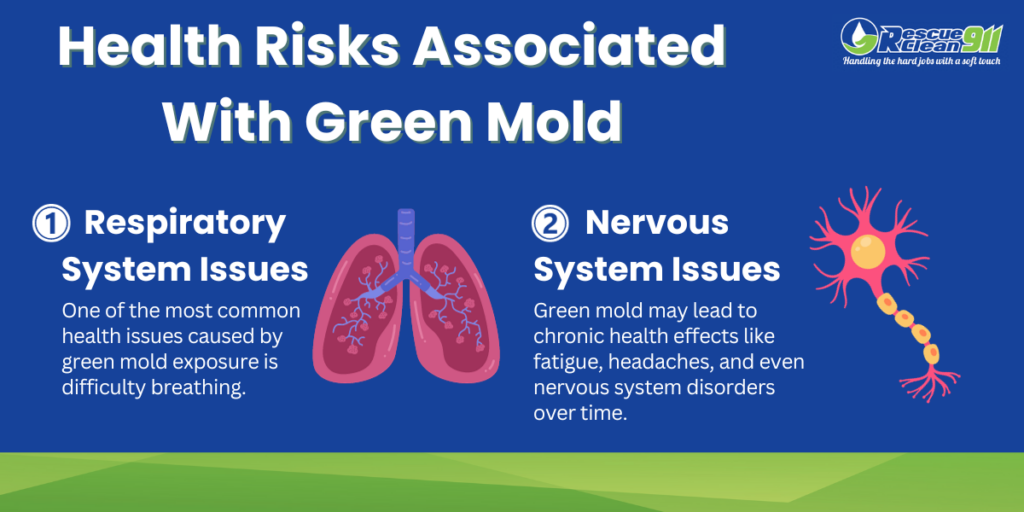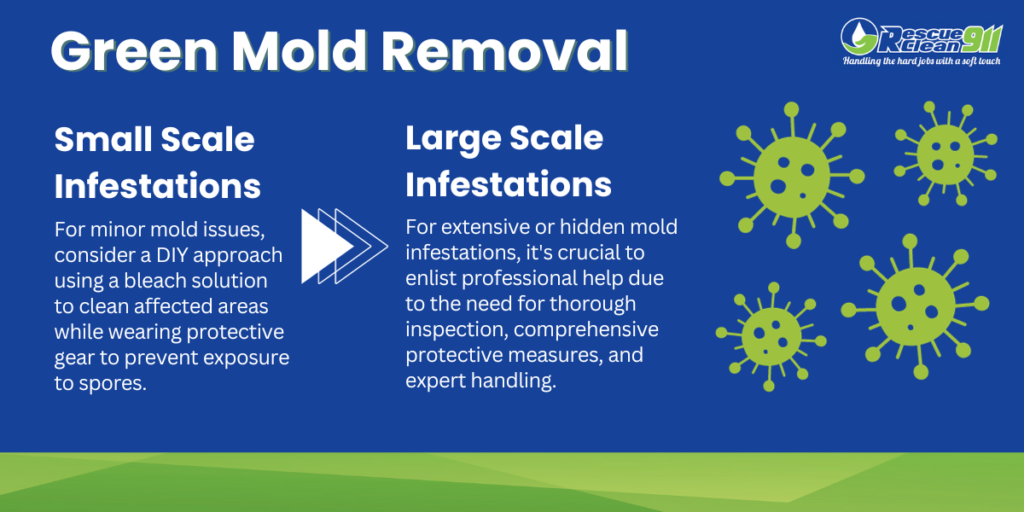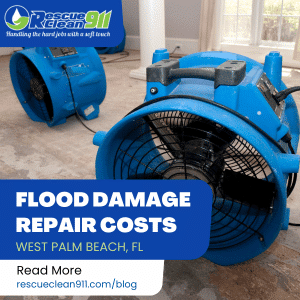Mold is a common household nuisance, but few people realize the extent of its potential for harm. Part of the fungus family, molds play an essential role in the breakdown of leaves, wood, and other plant debris. However, when they immigrate from their natural environment to our homes, they can become unwanted guests causing both health problems and property damage.
Green mold is not a single type of species. Instead, this term is often used to refer to several species of fungi with a similar green hue. These molds are found both indoors and outdoors, thriving in damp and poorly ventilated areas. While it might seem like an ordinary, everyday inconvenience, green mold can pose serious health risks. Having an understanding of what green mold is, its risk factors, and how to safely handle it is highly beneficial for every homeowner.
In the following sections, we will discuss how to identify green mold, the dangers it can pose to your health, effective strategies for removing it from your home, and, importantly, how to prevent it from coming back.
Identifying & Understanding Green Mold
If you’ve noticed a distinct greenish hue on your walls, ceilings, or other damp areas in your home, you might be dealing with a green mold infestation. Green mold refers to a variety of mold species that appear green, including Aspergillus, Cladosporium, and Talaromycosis. Each of these could potentially pose health risks, especially to those with mold allergies or compromised respiratory systems.
Detecting Green Mold
Green mold isn’t always easy to detect or differentiate from other types of mold or potentially harmful microscopic organisms. It might be confused with blue-green algae, also known as cyanobacteria, which is predominant in water bodies and can also cause several health problems. While green mold exclusively thrives on organic material in damp areas, cyanobacteria blooms occur in various freshwater bodies, especially during the early fall, when the nutrient levels are high.
Mold Testing
Mold testing plays a crucial role in identifying whether an unknown substance is green mold or something else. It can also help determine the species of mold. For instance, Cladosporium, a type of green mold, may exhibit different hues, while cyanobacteria blooms can give off a blue-green color. Therefore, mold testing ensures accurate identification, preventing harmful exposure, and facilitating quick remediation.
Where to Look for Green Mold
An essential aspect of understanding green mold is knowing where it thrives and why. Dark, damp, and unventilated areas provide the perfect environment for mold growth, such as basements, bathrooms, kitchens, or any other places where a water leak may occur. By knowing what green mold is and how it forms, you can catch it in the early stages before it escalates into a large mold infestation, damaging property, and affecting health among those exposed.
From this point on, awareness is the key. The best weapon you have against green mold is quickly recognizing and addressing it. If you suspect a mold infestation in your home, getting help from a professional remediation company like Rescue Clean 911 is a wise decision. We have the necessary knowledge, expertise, and tools to handle mold infestations and make your home safe and healthy again.
Health Risks Associated with Green Mold
While the exact health risks can vary from one type of green mold to another, prolonged or continuous exposure to its spores can undoubtedly trigger health problems. The mold spores, invisible to the naked eye, can easily become airborne and inhaled, which can result in various allergic reactions and exacerbate respiratory problems among those exposed.

Respiratory System Issues
One of the most common health issues caused by green mold exposure is difficulty breathing. This symptom is particularly pronounced among people with asthma or allergic rhinitis, as exposure to green mold can trigger asthma attacks or cause persistent sneezing. In extreme cases, it can also result in a serious lung infection.
Chronic Health Effects
In addition to respiratory issues, mold exposure can also have subtle but significant impacts on the nervous system. Long-term exposure to some types of mold may lead to chronic health effects like fatigue, headaches, and even nervous system disorders over time. Skin irritation is another common reaction, potentially presenting as rashes, blisters, or dermatitis.
Factors that Can Make Health Issues Worse
It’s also important to note the role that environmental conditions play in the adverse effects of green mold. High humidity levels, for instance, can encourage rapid mold growth and the proliferation of harmful algae blooms, which can exacerbate the negative impact of green mold on health.
Understanding these health risks helps underline the importance of immediate mold remediation. By removing green mold from your home, you can eliminate these health risks and ensure your living space is safe and comfortable. At Rescue Clean 911, we prioritize your health and safety, providing comprehensive mold remediation services to protect you and your family from the potential dangers of green mold.
Effective Removal Strategies for Green Mold
As overwhelming as a mold infestation may seem, it can be managed effectively with the right approach and, in most cases, professional assistance. The first step is to understand the extent of the infestation, which may call for professional mold testing. This will provide a clear idea of the type of green mold you are dealing with, its concentration, and the most effective remediation methods.

Small Infestations of Green Mold
For smaller infestations, a DIY approach may be sufficient. This often involves scrubbing the affected areas with a bleach solution, which can kill the mold and disinfect the non-porous surfaces. But remember to wear protective clothing and a mask to prevent direct contact and inhalation of spores during this process.
Large Infestations of Green Mold
When dealing with a more extensive or hard-to-reach mold infestation, it’s in your best interest to seek professional help. A large mold infestation or one that resides within your home’s walls or HVAC system requires detailed inspection, fully-fledged protective measures, and expert handling.
Professional Mold Remediation from Rescue Clean 911
This is where services like Rescue Clean 911 come in. As one of the leading mold remediation companies in South Florida, Rescue Clean 911 has a team of experts specifically trained to deal with all forms of mold infestations. With proper training and the right protective gear, we ensure effective and safe mold removal while preventing further spread within your home.
Our professional remediation process involves not just the removal of the mold but also an assessment of the cause. We help you identify what led to mold growth in the first place so that you can implement preventative measures and stop future infestations from occurring.
Battling green mold might seem daunting, but with our assistance, you don’t have to face this challenge alone. Rescue Clean 911 is ready to offer prompt and efficient mold remediation services, giving you peace of mind that your home is a healthy place for you and your family.
Prevention and Long-term Management of Green Mold
After successfully dealing with a green mold infestation, the next logical step is to prevent any future occurrences. This involves keeping the conditions inside your home unfavorable for mold growth and carefully monitoring for any early signs of green mold.
Minimizing the Risk of Mold
One key prevention tip is to control humidity within your home. Mold thrives in damp areas, so maintaining a dry environment can help keep an infestation at bay. Using fans and dehumidifiers to keep your indoor humidity below 50% can effectively deter mold growth.
Paying attention to the ventilation in your home can also help prevent mold infestations. Especially in areas like your kitchen, bathroom, and basement, where mold often grows unnoticed. Making sure these areas are well-ventilated can prevent the buildup of moisture that fuels mold growth.
Further, make a habit of quickly fixing any leaks in your home. Whether it’s from a pipe, the roof, or anywhere else, even a small amount of accumulated water can serve as a breeding ground for mold. Prompt repair prevents excessive moisture and diminishes the chances of green mold returning.
Call Rescue Clean 911
Lastly, you should have regular mold inspections by professionals like Rescue Clean 911 to stay one step ahead of any potential infestation. Our team can provide expert advice, maintain regular check-ins, and help ensure you never have to deal with the harmful health effects or structural damage caused by green mold.
Green mold, like any other mold, can turn from a minor irritation to a significant problem if not adequately addressed. Nevertheless, armed with knowledge about identification, removal, and prevention, you can ensure a healthier and safer home environment for you and your family. Call Rescue Clean 911 today!
Sources:
Centers for Disease Control and Prevention. “Mold.” Centers for Disease Control and Prevention, October 18, 2023. https://www.cdc.gov/mold/default.htm.
Centers for Disease Control and Prevention. “Cyanobacteria (Blue-green Algae) FAQs.” Centers for Disease Control and Prevention, May 2022. https://www.cdc.gov/habs/pdf/cyanobacteria_faq.pdf.
Centers for Disease Control and Prevention. “Aspergillosis.” Centers for Disease Control and Prevention, October 12, 2023. https://www.cdc.gov/fungal/diseases/aspergillosis/index.html.
Chen, Wenling, et al. “Indoor Mold Exposure and Respiratory Outcomes in Children: A Systematic Review and Meta-Analysis.” Frontiers in Pediatrics, vol. 10, 2022, p. 8271404. https://www.ncbi.nlm.nih.gov/pmc/articles/PMC8271404/.
Centers for Disease Control and Prevention. “Talaromycosis.” Centers for Disease Control and Prevention, October 12, 2023. https://www.cdc.gov/fungal/diseases/other/talaromycosis.html.
Centers for Disease Control and Prevention. “Controlling Mold in Your Home.” Centers for Disease Control and Prevention, October 18, 2023. https://www.cdc.gov/mold/control_mold.htm.
“Beyond Respiratory Issues: Long-term Mould Exposure Side Effects.” National Library of Australia. https://nlr.com.au/articles/mould-exposure-long-term-side-effects


